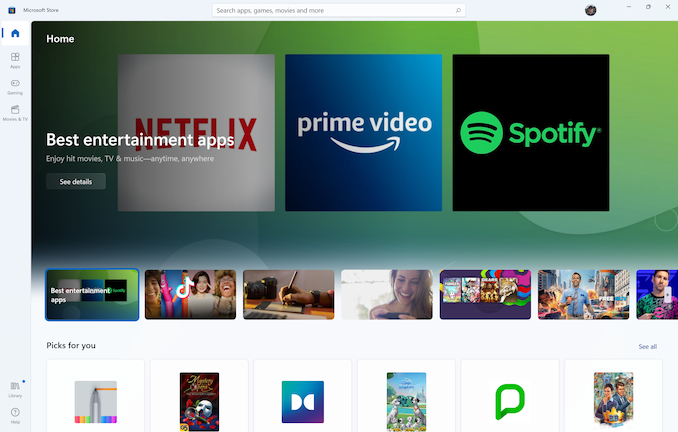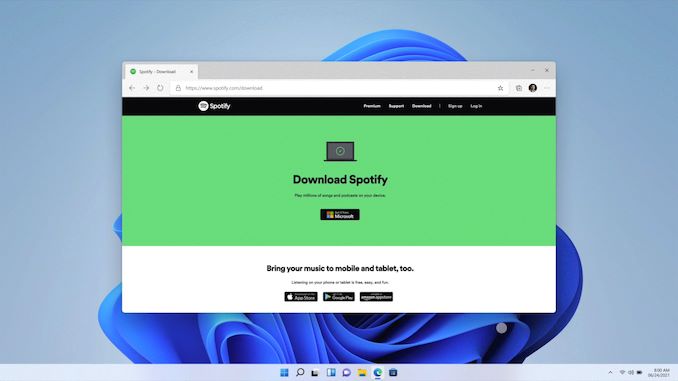What to Expect with Windows 11: A Day One Hands-On
by Brett Howse on October 4, 2021 4:00 PM EST- Posted in
- Software
- Operating Systems
- Windows
- Microsoft
- Windows 11
Microsoft Store
There are some big changes to the Microsoft Store model, although not all of them will be available at launch. Microsoft is dramatically changing their policies on what can go in the store, which should open the store up to more applications. Unlike the user interface changes though, the new store features/policies will be applied to Windows 10 as well.
When the Microsoft Store first appeared in Windows, it forced developers to utilize what eventually became known as Universal Windows Platform applications, or UWP apps. That nomenclature has morphed over time, and eventually Microsoft created methods for developers to publish more traditional Win32 applications in the store as well. The Windows 11 store dramatically expands this, allowing developers to publish any application built in any framework. Win32, .NET, UWP, Xamarin, Electron. React Native, Java, and of course Progressive Web Apps are now all supported frameworks in the store. This should immediately make the store much more useful to all users.
Microsoft is also changing the revenue share that they take from developers, perhaps inspired by some of the angst and anger directed at Apple’s App Store. The revenue share is now 85/15 for the developer for applications, and 88/12 for games. What’s more, if application developers bring their own e-commerce platform to their applications, whether one that is in-house or a third party one, Microsoft will take none of the revenue. In addition, Microsoft will be allowing stores within their store, so for example, Epic Games will be available through the Microsoft Store, but Microsoft will not take any of the revenue from Epic for any games sold. The only exception to these rules are video games distributed through the store – game developers will have to give Microsoft a cut regardless, which is perhaps not too surprising given that games are the single largest source of revenue on any of the app store platforms.
Overall, these are dramatic changes and should help the Microsoft Store be a place where people can actually find the apps they want and need. Which not only simplifies the install for the user, but provides a safety net compared to installing random software off the internet.
To be fair, Microsoft is not making these changes because they are a kind, generous company. They are making these changes to try to help the Microsoft Store compete. If applications do not show up in the store now, there seems to be little more they will be able to do to convince developers.
Android Apps on Windows
One of the biggest announcements for Windows 11 is Android application support, and Microsoft will be partnering with the Amazon App store to provide these applications. The underlying technology to support Android applications will be very similar to the Windows Subsystem for Linux, and will be called the Windows Subsystem for Android.
This is another key play for Microsoft to expand Windows 11 and bring additional functionality. Although Microsoft has supported tablet-style applications in Windows since Windows 8, they have never achieved very much developer support. That being said, Android tablet applications have never taken off in a way that most would have expected – Android tablets are predominantly used as portable TVs, as opposed to productivity devices – so we will have to wait and see if this is as big of a deal as promised.
The bad news is that, like many of the promised features for Windows 11, this is not available on launch day, and is scheduled to be available some time in 2022.
Install Apps from the Web
To simplify the experience, Microsoft will also be supporting a simplified install via pop-up on the web for sites that have apps in the store. This is something that other operating systems already support, but still nice to see.













95 Comments
View All Comments
flyingpants265 - Monday, October 4, 2021 - link
Forgot to mention, the various error reporters and virus scanners and updaters are regularly using 50 to 100% CPU on my laptop, no matter how much I try to stop them.If there were a viable alternative, I would use it. A viable alternative means being able to run ALL windows applications, inside a Windows Explorer interface. Let me know when it happens. Linux has been a catastrophic failure, capturing only 2% market share - it's so good, you can't even give it away for free. Macs are alright.
GeoffreyA - Monday, October 4, 2021 - link
I find ShutUp10 useful in curtailing 10's behaviour; and OpenShell to get the classic Start menu back. No classic Start, no Windows. Concerning Calculator, if you'd like the one from 7 back, there's a download, I think, on Winaero.flyingpants265 - Monday, October 4, 2021 - link
Didn't need any of those three things in Windows 7. I honestly forget the difference between 7 and XP, but I remember not completely hating 7.GeoffreyA - Tuesday, October 5, 2021 - link
XP and 7 were class.AbRASiON - Tuesday, October 5, 2021 - link
My god!!!!!!!!!!!! The Windows 10 Calculator! I've had it, after years of this thing. I hit run, type calc, enter - why is it taking up to near 5 seconds to open this junk WHY?Thanks, I'm finally going to replace it.
flyingpants265 - Tuesday, October 5, 2021 - link
Good point about it taking 5 seconds to open. A lot of things in Windows 10 are like that. Replacing bits and pieces won't help if the underlying codebase for the shell, services and applications is just bad.GeoffreyA - Wednesday, October 6, 2021 - link
It's a UWP application likely written in C# and .NET, and will be slower than the classic Win32 calculator.XJDHDR - Tuesday, October 12, 2021 - link
The problem is your PC. Win10 calc opens instantly for me.Gigaplex - Monday, October 4, 2021 - link
"Linux has been a catastrophic failure, capturing only 2% market share - it's so good, you can't even give it away for free."Linux has around 85% of the mobile (ie phones) market share.
flyingpants265 - Monday, October 4, 2021 - link
Yeah, exactly. Because it has corporate backing. They ("Linux community") couldn't do it by themselves, they just haven't done anything since like 1983. Goes to show that it could have been done anytime, they just didn't want to do it.Incidentally, it was Google that turned computers from tools into commercialized toys with Android. In Windows I can customize nearly every single aspect of the UI, background processes, hotkeys, I can open multiple windows at the same time and move things around. Custom ROMs are garbage and just give you the illusion of customization in an extremely limited OS.